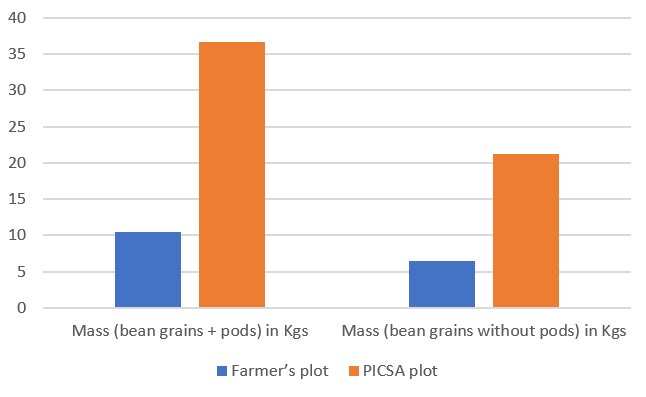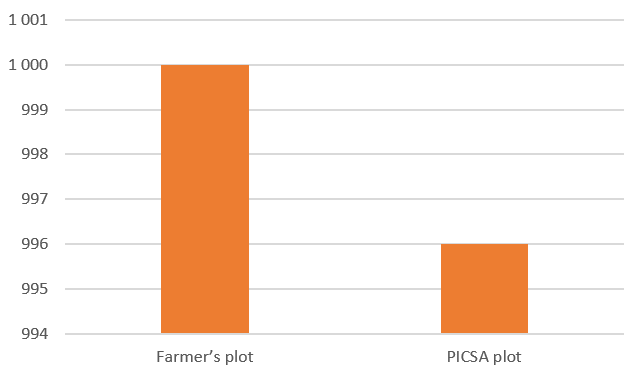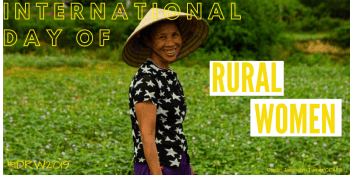Rwandan farmers share how climate information helps them improve food security

An open field day was organized for farmers to tell their neighbors how using climate information can increase agricultural yields.
In June 2018, the Rwanda Climate Services for Agriculture project staff, partners and donors[1] visited farmers who had been trained on climate services. During the field visit, farmers shared what they learnt from the Participatory Integrated Climate Services for Agriculture (PICSA) trainings and how they applied this learning in their decision-making processes.
Plant on time and follow the forecast!
Athanase Mudenge, a farmer promoter from Ruhuha, Bugesera District, established experimental trials on his farm. One section of the farm is a “PICSA plot” where he applies improved practices learned through the training, and the other is a “farmer’s practice plot” for farmer’s usual practices. Each section has a size of 10 m2.
A total of 35 farmers attended the event and conducted an assessment of the practices and technologies applied in the two plots. Through a participatory exercise, farmers identified the following assessment criteria: number of bean plants germinated, the height of the bean plant, the vigor of the stem, pest and disease infestation, number of pods, width (size) of the pods, and number of pods without grains.
Similarly, farming practices and technologies were assessed, and farmers agreed that timely planting based on weather forecasting, application of inorganic fertilizer, use of certified seeds, crop rotation, use of soil and water conservation (e.g. ridges and mulching), and row planting and optimum spacing are all practices that contribute to higher productivity.
Following the visual assessment of the two plots, the next step was to harvest the plots and weigh the biomass and grain yield that came from each plot.
Figure 1. Mass weight in kgs on the farmer's plot vs. the PICSA plot
Figure 2. Number of harvested plants.
Results from the exercise (Figure 1) showed that the yield had tripled for the “PICSA plot” compared to the “Farmer’s plot”.
“Planting on time is the best starting point in the use of improved agronomic practices,” said Mudenge. “To achieve this, you need to prepare the land early, look for all inputs and get ready for the season to start,” he continued. Additionally, the seasonal and daily forecasts should be strictly followed. Mudenge encouraged his fellow farmers to adhere to this guidance, emphasizing that when the season does not go as well as expected, smart agricultural techniques are available to address that challenge. He also mentioned some of the smart techniques, which include those that he used in his trial plots like mulching, planting early maturing crop varieties, water harvesting, efficient fertilizer application, and others.
Farmers should see the variable climate challenge as an opportunity to utilize smart farming techniques
The Project’s Agreement Officer Representative (AOR) from USAID Rwanda who was part of the visit emphasized that the difference is obvious from the two sets of trial plots and that farmers should see the variable climate challenge as an opportunity to utilize smart farming techniques.
Ranking practices to implement for increasing yields
Ngendahimana Jean Paul, a farmer promoter in Ntarama Sector of Bugesera District, attended a training on PICSA where he learnt how to manage both the household and the farm using climate information to inform his activities. Following the training, he decided to dedicate a small portion of his land to a trial where he applied what he learnt through the training.
During the first season, he planted maize and observed an increase in yield. This motivated him to grow beans during the following season and he observed an increase in yield once again. He is now more than confident that the practices he implemented are the primary cause of the increased yield for both maize and beans.
"I now adhere to the planting time once I get the seasonal forecast and I always look for improved seeds. I plan to expand my farming activities using these practices because I am sure that I will get higher production. The difference with applying climate information and agronomic advisories that came with PICSA training is obvious in my plots and I urge all my neighbors to follow my example.”
Following the visit, farmers ranked the practices in order of importance according to their perceptions and based on affordability. The 20 farmers were split into two equal groups of women and men.
Results are shown in the table below starting with the most important and affordable according to each group.
Practice | Men ranking | Women ranking |
Planting on time | 1 | 1 |
Improved seeds | 2 | 4 |
Inorganic fertilizer | 3 | 6 |
Organic fertilizer | 4 | 7 |
Row planting and optimum spacing | 5 | 5 |
Tied ridges | 6 | 3 |
Mulching | 7 | 2 |
Farmers were happy to learn that they could work together and pool resources to implement the different practices.
Ngendahimana’s trial plots were then harvested and the biomass and grain yield were weighed. The measurements suggest almost a double yield from the plot with practices learnt though PICSA training comparing to the control plot with farmer’s usual practices.
Following the field visit, farmers were encouraged to work closely with their local authorities and the Rwanda Climate Services for Agriculture project partners to seek relevant information that will boost farm productivity. It was emphasized that climate information is readily available through the local authorities and the project’s local partners.
The PICSA approach is being implemented across the whole country to help farmers in Rwanda increase their agricultural productivity and adapt to a changing climate.
Read more:
- Project page: Building climate services capacity in Rwanda
[1] Partners and donors participating in the field visit were: USAID, Caritas Kibungo, and Meteo Rwanda.
The Rwanda Climate Servies for Agriculture project is supported by USAID Rwanda and coordinated by the CGIAR Research Program on Climate Change, Agriculture and Food Security (CCAFS). Main partners include Meteo-Rwanda, MINAGRI, Rwanda Agriculture Board (RAB), International Centre for Tropical Agriculture (CIAT), International Livestock Research Institute (ILRI), World Agroforestry Centre (ICRAF), International Research Institute for Climate & Society (IRI) based at Columbia University, Reading University, Radio Huguka, DERN, N-Frnds, and Caritas (Caritas Kibungo, Caritas Butare and Caritas Kibuye).
Gloriose Nsengiyumva is the Rwanda Climate Services for Agriculture Project’s Outcome 1 Coordinator based at the International Center for Tropical Agriculture (CIAT) in Kigali, Rwanda. Desire Kagabo is the Rwanda Climate Services for Agriculture Project Coordinator based at the International Center for Tropical Agriculture (CIAT) in Kigali, Rwanda. Yvonne Munyangeri is the Project Assistant for the Rwanda Climate Services for Agriculture project, based at the International Center for Tropical Agriculture (CIAT) in Kigali, Rwanda. Catherine Mungai is the Partnerships and Policy Specialist at CCAFS East Africa.





